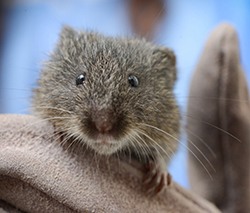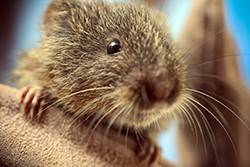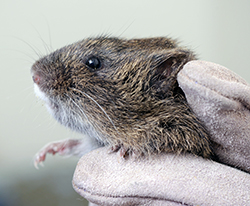


A tiny, endangered mammal is the subject of an extraordinary conservation effort near the communities of Shoshone and Tecopa in Inyo County.
The Amargosa vole is unique to the Mojave Desert, and today, scientists estimate there are only about 500 remaining in the wild. Though the Amargosa vole is rarely seen by humans, biologists recognize that it is a key link in the native food chain. Predators, including raptors and water birds, share the desert marshes where they live, and the extinction of the Amargosa vole would have a ripple effect on these and many other species as well.
For a year, a scientific team consisting of CDFW, UC Davis and US Geological Survey biologists have conducted intensive research into the life cycle of this little vole. The team visited every marsh that potentially could be inhabited by voles – they mapped the marshes, assessed habitat quality, and determined whether or not voles were present. In a subset of larger marshes the team conducted more detailed assessments of water inflow-outflow, soil moisture and vegetation, and captured voles to estimate local population numbers, assess the health of the voles and take samples for disease and genetics studies. In addition to the hands-on study in the desert, they also studied satellite data to track the amount of vegetation and water in the area over a period of time. A grim picture emerged of a habitat range in decline, due in large part to climate change and human modification.
Some of the findings included:
- Total available habitat for the voles decreased 37 percent between 2012 and 2015.
- Over decades, global climate change has caused a gradual decrease in water in this region. California’s recent drought has exacerbated the problem.
- Of the more than 80 marshes that were documented at the beginning of the study, about 60 have degraded and/or dried up. Those that remain are almost all too small to sustain vole populations. Just as pandas eat only bamboo, the Amargosa vole survives solely on bulrush, a plant that grows in desert marshes.
- Another important finding was that 80 percent of the individual voles found and tracked during the study were adults. This indicates low birth rates and survival rates for juveniles – more barriers to the species’ recovery.
Scientists believe that the network of springs and marshes in the vole’s natural range has been so extensively modified by humans that the vole’s future existence will depend almost entirely on whether humans continue to supply water where and when needed. They found evidence to support this, as an intensive restoration effort at one of the largest marshes showed signs of successfully supporting and sustaining voles.
The report authors identified several specific measures that could be taken to increase vole habitat and improve their chances of survival – including reconfiguring water inflow and outflow, changing elevations and planting vegetation that would enhance existing marshes and/or better connect adjacent marshes.
This study is part of a larger long-term effort to secure a future for the Amargosa vole and the unique marsh ecosystems it depends upon in the Mojave Desert. In late 2014 vole numbers became so low that scientists initiated a captive breeding program at the UC Davis School of Veterinary Medicine to reduce the risk of extinction. Today more than 100 voles are in the captive colony at UC Davis – providing a potential source of animals for release into restored habitats, and an important insurance population to prevent extinction.
Photos by Don Preisler/UC Davis School of Veterinary Medicine